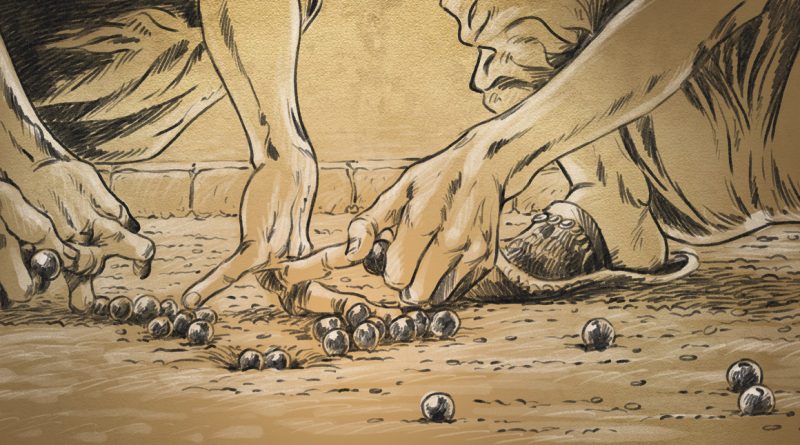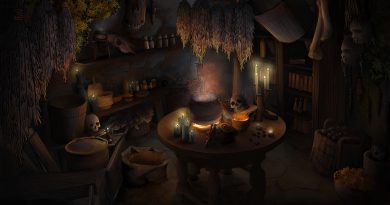Daily life, part 4 to 6
4- Men, women & gender
For the Church of the Council, and consequently for Lossyans living under the yoke of its Dogmas, man, here understood as the individual of the male sex, dominates everything. It would seem unthinkable to the traditionalist Lossyan that a woman in his household would even dare to entertain the idea of not blindly obeying him or rebelling against his authority. For a Lossyan, women are weak and inferior to him. It is his duty to protect her, to look after her, but also to use any means to make her obey and submit to his authority. The majority of Lossyans therefore consider that a woman’s place is in the home, close to the children; and that she should not meddle in the affairs of men, nor lead, let alone fight. For the hardest societies, this sexism borders on misogyny, and the illusion of the weak woman, inferior to man in every way, subjugated to him by the Dogmas of the Council, is a reality that cannot be discussed.
We’ve already mentioned that the further south we go and Armanth and its progressive society, the more this principle tends to moderate. However, it is a woman’s honor not to disobey her husband or father, at least not in public. A rule less strictly observed with brothers or uncles, for example. While in the northern part of the Eteocle Plains, it’s unimaginable for a daughter to stand up to her brother, it doesn’t really offend anyone on the southern shores of the same region. The regions hardest up against these laws are the Hegemony, Hemlaris, the United Cities and the Fringe peoples. Whereas among the Dragensmanns and Genenemons, for example, it’s perfectly acceptable for a woman to stand up to her family.
Traditionally, a woman cannot bear arms or defend her honor. The harshest custom even condemns to severe punishment any woman who dares grab a weapon or lay a hand on a man, even if he attacks her. Such extremes are uncommon, but the fact remains that a woman’s place is in the home, and she must neither touch weapons nor learn to fight.
But that doesn’t stop some of them from doing so. These are the Swordswomen, and they are rare. Among the Hegemonians, they are only Ordinatorii of the Church’s legions: any other woman wishing to defend her own honor will end up enslaved or tortured. But the further south you go, the more of them you come across, however uncommon, and that makes Lossyans both curious and uneasy.
For all the other women of Loss, custom and law are hardly in their favor. But what makes up for this rather sad picture is that for most people, a woman, though legally inferior in rights to men, remains not only an individual displaying Virtues to be respected, but also a productive and indispensable citizen. Her value and labor power are universally recognized, and ultimately, it is only in the highest strata of society that this difference in treatment between men and women can be felt most acutely, where women’s labor power, and therefore their importance and usefulness, can be dispensed with.
In Armanth and Athémaïs in general, but also in Terancha and among the Jemmaïs, the legal protection of women in the family circle became egalitarian. They were granted divorce, inheritance and property rights, and the right to lodge complaints in the event of abuse or domestic violence. They are also valued more highly. And in these regions, a man who beats, or worse, enslaves his wife or one of his daughters, can lose his reputation and therefore his honor, if he doesn’t end up in court on a complaint from his own family.
SEXUALITY & GENDER ISSUES
There is a generic Lossyan term for homosexuals, derived from the Teranchen dialect: they are known locally as Kaenogillys (a word which literally translates as “those who love themselves”), and the widespread term is “Gillys” (“those who love”).
Homosexuality and gender issues do exist in Loss, but contrary to what you might think, they’re not as dramatic a problem as they are for 21st-century humans. Lossyans haven’t practiced rejection and exclusion, it’s much more complicated than that.
The explanation by example will be more telling: what to do when a brave and honorable military officer, holding his rank and position, turns out to prefer men? Should the fact that he is a homosexual override the virtues he displays and which are recognized by all? For a Lossyan, the answer is no. To do so would be to deny his value and virtues. What will be much more problematic for the same Lossyan is if the individual’s sexuality jeopardizes his rank and function.
In short… this must not be seen, even if everyone knows it, and Lossyans sometimes prefer it to be known when they wish. But it must not be displayed publicly. Failure to respect this binding rule would be considered a dishonor, and sometimes a serious offense: both the Church and morality officially condemn homosexual relations. But the Church is hardly in a position to give lessons: within its own legions, such relationships are commonplace.
Even so, it’s hard to live serenely with homosexuality in a patriarchal society which demands that men and women fulfill the duties of their place, such as giving birth. It’s even more difficult and unfair for women, as you might imagine. Yet tragedies are rare enough. While homosexuality is frowned upon and those concerned tend to hide it, it is common for families to admit it. They will then impose certain constraints, such as requiring a woman to give birth at least once, even if it means breaking off the marriage afterwards. Similarly, despite his homosexuality, a man will have to find a wife and start a family. As adoption is accepted instead of childbirth, refusal to procreate is not so serious.
There are few homophobic crimes in Lossyan cultures, but they do exist. However, even if public regard for homosexuals is hardly flattering, the homophobe who flaunts his hatred will easily be disgraced in the eyes of Lossyans.
Gender concerns exist on Loss just as much as sexual ones. And if it’s very complicated for everyone, it turns out that here too, Concilian society has given them a place and found certain solutions to these problems, albeit not without a few bumps in the road.
Gydreïs
There is a type of symbiont, originally developed by physicists to control female fertility, which so effectively alters the human hormonal system as to completely modify all secondary sexual characteristics. Gydreïs is used by transgender people to give their bodies the apparent gender with which they identify.
This symbiont is particularly effective and its effects are powerful, but it does not actually mutate the reproductive organs. While it can make breasts disappear altogether, erase all body hair, transform a woman’s appearance into a man’s and vice versa, this mutation is not a total transformation. As for surgery, it can do nothing more, and no Lossyan physician would venture into this field. Gydreïs are not widely available: they can only be obtained from Courtisan brotherhoods.
The Courtisans
This term covers a very diverse community, not all of whom are transgender. These are brotherhoods of intersexuals, transvestites and gillys (homosexuals), all versed in the arcana of seduction, court etiquette, discussion, music and other art forms. They are entertainers and companions, linked to luxury prostitution. It’s a service that Courtesans are trained to provide, but it’s far from systematic.
Courtesans often play on their apparent sexual or social ambiguity. Not all Courtesans carry a gydreïs, far from it, and there are just as many men as women. Courtesan guilds, however, are often refuges that warmly welcome anyone harassed or endangered by their gender issues. They do not necessarily become Courtisans, but will work within their guild.
Courtesan brotherhoods are the only environment where a gilly can openly display his homosexuality, whether as a customer or a service provider. Most major cities have one or two Courtisan brotherhoods, with entertainment establishments, pleasure and bath houses, and inns confined to one or more well-defined districts. The Church condemned prostitution, but turned a blind eye to the activities of Courtisans. In the Hemlaris Empire, they are considered a public social function, and their activities and recruitment are governed by complex traditions. It’s a very Concilian tradition, and a fairly recent one at that.
It’s worth noting that Courtesan establishments only employ slaves in their activities for household chores or on a private basis. Some Courtisans are leading figures in high society, especially in Athémaïs. Lossyans generally accept the existence of Courtesans and their presence, but it’s not a subject that’s discussed at the dinner table.
5- Education & work
The vast majority of Lossyans can neither read nor write. Generally speaking, in a city-state, around 25% of citizens will be able to read, and less than 15% in rural areas. Education, like learning a trade, was passed down from parent to child, but the influence of guilds and corporations, after that of the Church, created a whole network of schools and academies where craftsmen, geniuses, artists, accountants, magistrates and other intellectuals were trained. As a result, know-how and skills became increasingly widespread, aided by the widespread use of paper and printing.
But work and trades were still largely a family affair. Workshops were often small, large industrial plants rare and machine tools often prohibitively expensive. The vast majority of manufactured goods are still made by hand, although industrialization is advancing steadily in the military, construction, drapery and marine industries. Agriculture, too, was largely family-run, benefiting from advances in irrigation and soil management, but employing a large workforce and few machines.
THE WORK
The day begins shortly after dawn and ends at dusk. We eat well in the morning and in the evening, with a break at midday for a bite to eat.
Rural work employs all available hands, often as young as seven. Men and women work in the fields and on the farms, whenever the weather permits. Rest days are rare, as agriculture does not allow for them, especially in the coldest regions where the semi and harvest seasons are short. The lossyanne year, however, allows for two to three harvests a year, depending on sowing and climate. Often, the fields are shared by a community, and part of the harvest and profits are shared equally. Large landowner plantations are not the norm, nor is serfdom, which has all but disappeared except in a few regions of the Hegemony and Eteocles. As a general rule, however, farmers are poor, and a year of crop failure can be enough to put them at risk.
In the cities, work is punctuated by the gongs of the Church and the belfry bells of the great guilds. Work often continues after dark, unless the town forbids it for fire safety reasons. If the poorest craftsmen and tradesmen make their children work, we send them to school as soon as we can and if we can afford it. Everyone worked, including women, except the upper bourgeoisie and the aristocracy. However, life is easier and vacations more plentiful in the cities. But city-states depend on rural communities, and food supplies are rarely sufficient to last more than a few months.
A look at work
Lossyans see no sanctity in work, and will say without hesitation that they don’t like it. What is respected is the fact of producing something of value or creation with one’s hands, but not the work itself, which is a constraint.
If you don’t want to work, you have to be rich, which is a source of prestige for Lossyans, but it’s not a necessity: if a man has enough means of subsistence to be able to work less, he’ll choose idleness over hard work to save even more. As a result, being idle is not really seen as a bad thing, and a man who has the opportunity to work less can devote his time to his family and friends, which is highly regarded. What is less accepted is not assuming one’s responsibilities and avoiding work when one has a family in need.
So, if you can afford it, you’ll avoid putting your children to work, and you won’t scold them for playing rather than working or studying. The same goes for young students in schools and universities, where idleness is totally accepted.
EDUCATION
One very important thing to remember: for all Lossyan peoples, the child is sacred and often treated as a child-king. Until their seventh year, boys and girls are pampered, do not work and can play freely, usually with minimal parental constraints. From the age of seven onwards, they often help their families with work in the fields, enter a school or apprentice, but if the family is wealthy, they remain pampered and very free until the age of 14, the age of majority for Lossyans.
Basic education covers reading, writing and arithmetic. The most common schools belong to the Church, which also uses them as recruitment centers. Guild and guild schools are also common in the south.
There are three main types of training at Lossyan universities: engineering, for architects, surveyors and engineers; mdical sciences, for the physicians professions; and literature and law, for accountants, the literary and judicial professions and public writers.
These courses take place on different premises: the universities belong to guilds, congregations or brotherhoods that educate their own children, while others have to pay a high price. Training is linked to apprenticeships with masters who will keep their disciples for several years.
Lossyane university training made no distinction between graphic arts and engineering techniques. Nor does it yet recognize the difference between theoretical and applied sciences, and ignores the concepts of fundamental physics. There are no “scholars” devoted to an exclusive field of study, except in the medical or literary fields. Science and knowledge must have a practical application in the arts and techniques.
6- Leisure & games
Lossyans like to have fun and relax, and know how to keep themselves busy. Most leisure activities are social and take place outdoors: except for the wealthiest, a Lossyan home is often narrow, overcrowded and poorly lit, so when you want to relax, you prefer to do it outside.
Street entertainment
Street acrobats, street theater, musicians and troubadours, conjurers and animal trainers are legion, as are the “attrape-nigauds” running gambling stalls right on the street. These shows are to be found on every street corner, and the acrobats are respected even if distrusted, because with them, you can always expect thieves and fortune-tellers to appear.
Arena battles
City-states often have arenas and amphitheaters dedicated to these spectacles, which often take place during the day on vacations and feast days. Gladiators are slaves trained by professional trainers and weapons masters. The fights are codified to avoid losing too many gladiators, but it all depends on the whims of the organizers and the price they are willing to pay for a bloodbath to delight the public. However, even if they are slaves – Lossyans don’t like gratuitous deaths – gladiators are rarely sent to the slaughterhouse. Public executions in the arena are very rare. These shows are often free of charge.
High-Art contests
Trained slaves are presented as masterpieces, and slaver masters like to show off their docility and talents for dancing, singing, seduction and blind obedience in particularly colorful and luxurious shows, sometimes followed by auctions of the slaves presented. Some of these contests are public and held in amphitheaters, and they are awarded prizes, rather like those offered to show horses or dogs. These shows are always ticketed.
Theater and opera
Theater is performed in more or less suitable halls, sometimes on the streets themselves, but also in amphitheatres for shows with luxurious means and for a wealthy clientele. The same applies to opera: Lossyans love to sing, and singing and music as artistic performances are very popular. The best actors, directors and singers, and even some composers and musicians, are real stars, courted by the wealthiest patrons to organize shows for their benefit. Some public performances are sponsored and free, and often take place in the evening.
Taverns
Alongside street and arena shows, the taverns are where Lossyans are most entertained. First and foremost, you go there to drink, chat, play dice and cards, maybe do some business and go home after curfew. There are different types of tavern:
– Boozers (or canteen) are taverns with bad beer, not always quality spirits and menus of ratas and soup whose composition is best ignored. Often, people come here to eat the food they’ve bought at the stalls outside. Sleeping facilities are rarely available, and when they are, the best they can offer are piles of straw and benches in the common room.
– Breweries offer brewed beer, wine and various spirits, and the food is more varied and of higher quality. They are also more spacious and often have discreet alcoves. It’s not uncommon to see a variety of shows, or to find battling cages. Some breweries provide good hotel services.
– Smoking salons are taverns where luxury reigns and include the best kumats and teas, the finest spirits, the most exotic drugs, the most varied services, from baths to massages, luxurious guest rooms and exotic sexual services. These smoking parlors were open to all kinds of fantasies and were often run by courtiers (see above).
Games
The most common games are dice and cards. In general, these are more or less elaborate games of chance or bluff that are only interesting because money is involved, such as Jhaemo, a card game reminiscent of belote, where the emphasis is on betting and bluffing, and Part-points, a rather strange dice game based on a wager to get as close as possible to a given number without exceeding it, using two pairs of dice. We also play a lot of marbles while betting. And we love singing and declaiming, or poetic insult, drinking and arm-wrestling contests. Music is very common and practiced, and when there is music, it’s often for dancing.
Board games include hopscotch, Katawa, a Frangian betting game similar to backgammon, using an abacus and cards, and Meteretron, a complex cross between chess and abalone considered the king of strategy games.
Sexual entertainment
Access to sexual services is not restricted to men: depending on the region, there are places for free women that are perfectly acceptable. The risk of becoming pregnant is greatly reduced by the existence of different types of symbionts that render men and women infertile. The second point is that sexual recreation is not confined to brothels and their Houris and Slave Gardens. There’s plenty of prostitution, even if it’s frowned upon. As for the Courtisans, they have their very public Smoking Salons.
The lowest rung on the ladder are the prostitutes: the lowest social class, including men, who sell their bodies on the street. This is a degrading and dangerous activity, forbidden by the Church.
Then there are the Houses of Houris, low-class brothels where slaves, chained up in gloomy alcoves, are forced to slaughter for carefreec ustomers. The slaves who end up there suffer one of the worst fates in bondage.
Slave Gardens are a kind of harem where a wealthy person can enjoy the pleasures of slavery in luxurious surroundings. The level of quality differs according to luxury and price, and some are havens of the most luxurious and unbridled sexuality. There are a few Slave Gardens open to women, with both male and female slaves.
Courtesan Smoking Salons are discussed above.




